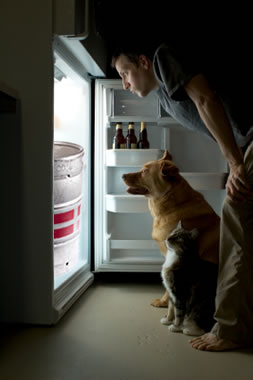 |
Lagering beer can be problematical for home brewers, if they are not properly equipped. The key is that, for home brewing, kegs and lagering go hand in hand with the handy home bar invention called the kegerator. A kegerator can do two things at once – act as a lagering closet and serve beer. If you want a little more control with your lagering temperature, you may opt for a lagering closet or separate fridge or freezer conversion.
The ideal lagering temperature for beer, according to white labs, manufacturers of specialty brewing yeasts, changes over the lagering period. Ideally, the lagering process starts out at 51 to 53 degrees. This temperature is maintained for the first week, and then the beer is allowed to warm to 62-64 degrees for four to six days. After this, white labs recommends lowering the temperature five degrees per day until the ideal long-term lagering temperature of 31 to 32 degrees is achieved. Then, lagering for six weeks at the lowest temperature takes place.
This is the most complicated lagering scenario I have heard of. Most home brewers do not maintain such precise controls in any their brews, but it is clear that one would need to have a precise temperature controlled lagering closet in order to produce a lager of such exacting qualifications. Keep in mind that the process of lagering was first developed by Bavarians keeping their beer in caves.
I would recommend a slightly more low-tech approach to lagering. By utilizing your kegerator, you can lager your beer at roughly the same temperatures, as long as you are not serving beer at the same time (except at the final lagering stage, if you fudge the temp up to the regular serving temp of 38 degrees). For the homemade conversion-style kegerators, there is plenty of room for an additional Cornelius keg, and sometimes a Sanke keg.
It is at this final stage that the keg comes into the picture. This is the perfect time to transfer your lager beer into a keg for its final fermentation stage. By lagering your beer in the keg for its final fermentation cycle, you can ensure that it will be a simple process to serve your beer. After the fermentation is complete, simply tap the keg onto your beer line and serve. No need to move the keg around and let it settle – although be sure to clean and sanitize your beer lines between each keg.
A custom temperature control can be installed into your kegerator or lagering closet if you do want to maintain such precise lagering controls as described by White Labs. Johnson Controls produces what is probably the easiest to use temperature control unit. The Johnson Controls unit plugs right into he wall and controls the power coming into your kegerator or freezer, turning of the power when the temperature reaches the right reading, and turning the power back on when the reading goes above the dial.
Whether you go low or high tech, lagering beer at home can be a challenge if you don’t have a kegerator or temperature controlled freezer / lagering closet. It is not an impossible challenge, however, especially not for the home brewer who knows how to get things done.


